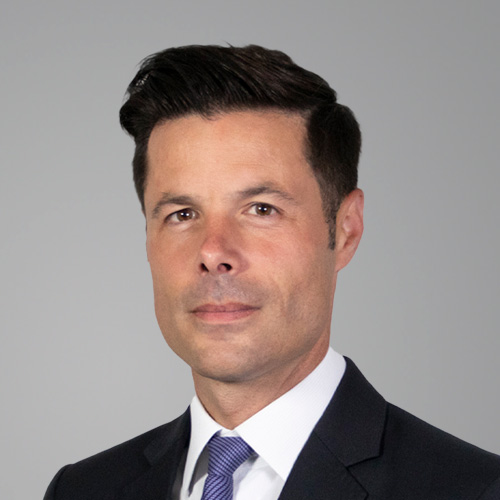As 2023’s concentrated market rally is extending into 2024, equity investors are worried about a potential consolidation or pullback.
Risks of disappointment caused by geopolitics and elections, interest rate moves or AI inadequacies are high. They could weigh on market sentiment after the accumulation of more than 30% returns since the end of 2022, more than making up for the -18% performance drawdown recorded in 2022 (MSCI AC World NR index in USD).
Looking at the more balanced MSCI AC World Equally Weighted, its rolling two-year performance is still in the red, reflecting how narrow the market has been. Yet, over the longer term, that index delivers stronger annualised performances than the MSCI AC World – +7.3% vs +6.1% from 31.12.1998 to 29.02.2024 – proving the benefits of a more diversified portfolio compared to a systematically rebalancing one.
Momentum on a Global Scale
Geographically, global equity markets are currently showing considerable exposure to the US with 70% of the MSCI World consisting of US names, the highest weight reached in 100 years. Furthermore, the ‘momentum’ approach has been strongly outperforming other investment styles so far this year, since 2023’s winning stocks have kept outperforming into 2024, confirming the limited market breadth. The ‘momentum’ factor tracks recent winners but nevertheless struggles when there is a rapid change in market trajectory as it rebalances with a lag: it was the worst-performing style in 2023 and 2021 when the market shifted into rally gears.
US: The Magnificent Seven still Dazzling the Market
On a regional level, some local markets are also showing high levels of concentration. Starting with US equities, the “Magnificent 7” tech behemoths have been driving markets over the past months. The leadership of the tech sector and large market caps is especially pronounced with mega-cap tech names reaching the largest weights in the US indices. Overall, the 10 largest stocks currently account for around 33% of the S&P 500, well above the 27% share reached at the peak of the tech bubble in 2000.
The earnings picture is also dominated by these names, which account for 25% of EPS growth expectations for 2024. Valuation levels are high, at 21x for the S&P 500, although not as extreme as during the 2000 bubble, when they reached 25x. Investors that generally prefer passive allocations to US equities are seeing concentration increase despite also holding the lower-growth parts of the market. Through passive solutions, investors are closely following the largest market winners, but are also exposed to the risk of being tied to the largest losers, should the market trend reverse abruptly.
Europe: Nuts About the Granolas
In Europe, it’s the 11 giants known collectively as the Granolas that have taken centre stage. They have been powering up half the performance of the Stoxx 600 in the past year, with a 25% weight and a combined market capitalisation of EUR 2.6 tn. How do they compare to the US Mag 7 names? Similarly, they are internationally exposed, quality growth compounders, but they show lower volatility than the Mag 7, with lower valuation levels. Concentration risks could be less biased to one sector in the European market, but are still worth pointing out.
The Swiss heavyweights Nestlé, Roche and Novartis have generally formed more than 45% of the SPI in aggregate. While Nestlé and Roche in particular can look back on a long history of sustainable and attractive levels of value creation, all three companies currently face some headwinds. 2024 could reveal opportunities at the other end of the Swiss equity market, namely in the quality small- and mid-cap space, which can’t be accessed via passive solutions. A supportive environment for that segment should be confirmed in 2024, with the prospect of a GDP growth recovery now perceived by the market as more tangible after the SNB’s move to cut rates by 25bps in March.
Japan: Hot Topix
Although the Japanese market may seem less concentrated, deeper inspection reveals nuances to bring into the comparison. The expansive nature of the Topix index, comprising nearly 2000 companies, demands attention. Notably, the proportion of the 30 largest entities within the Topix has grown remarkably, reaching their highest weighting since 1995. This trend is reminiscent of the concentration of the Mag 7 in relation to the 500 other companies constituting the S&P composite index. This goes to show that, if you scratch the surface, you will see different market structures and more evolving complexities than first meet the eye.
Navigating the Narrow Straits
An important question for 2024 is: will the market stay narrow and how should investors handle it? When the risks of a negative market surprise are elevated, passive solutions can pose fundamental challenges, especially given the current concentration levels at both global and regional level, as outlined above.
Research shows that in times of recession or challenged fundamentals, corporate profits drop 20% on average on a yearly basis, driven by cyclical margins and lower pricing power. In this market configuration, active strategies delivering diversified sources of performance through bottom-up stock selection are likely to fare better.
Focusing on building a diversified and balanced portfolio of value-creative companies has proven – over 2023, but more importantly over any market cycle – most likely to deliver consistent results that are less driven by active bets on regions, sectors or market caps. For 2024, investing in strategies that aim at beating the risk of “mean reversion”, which is often observed following concentrated market rallies, could be worth considering for investors. There are such strategies to be found, whether in global, European and Japanese equities, Swiss SMIDs or tech stocks.










